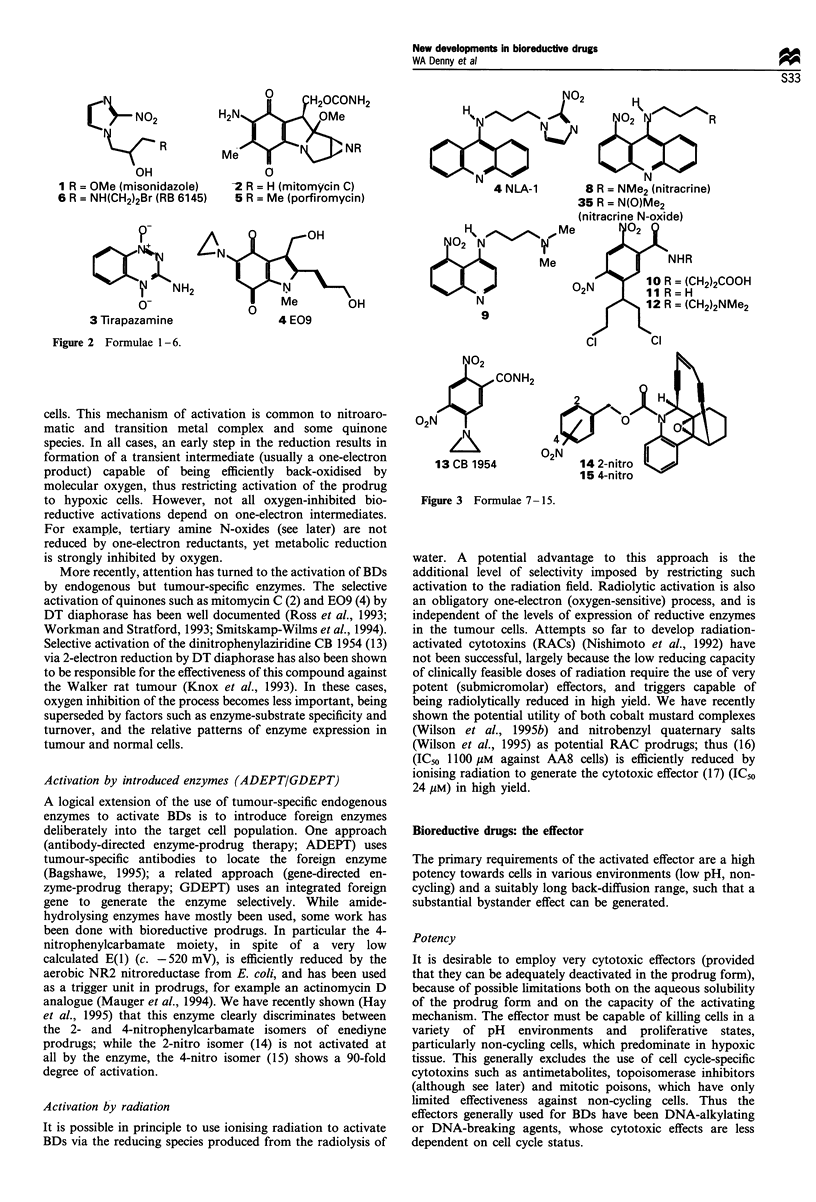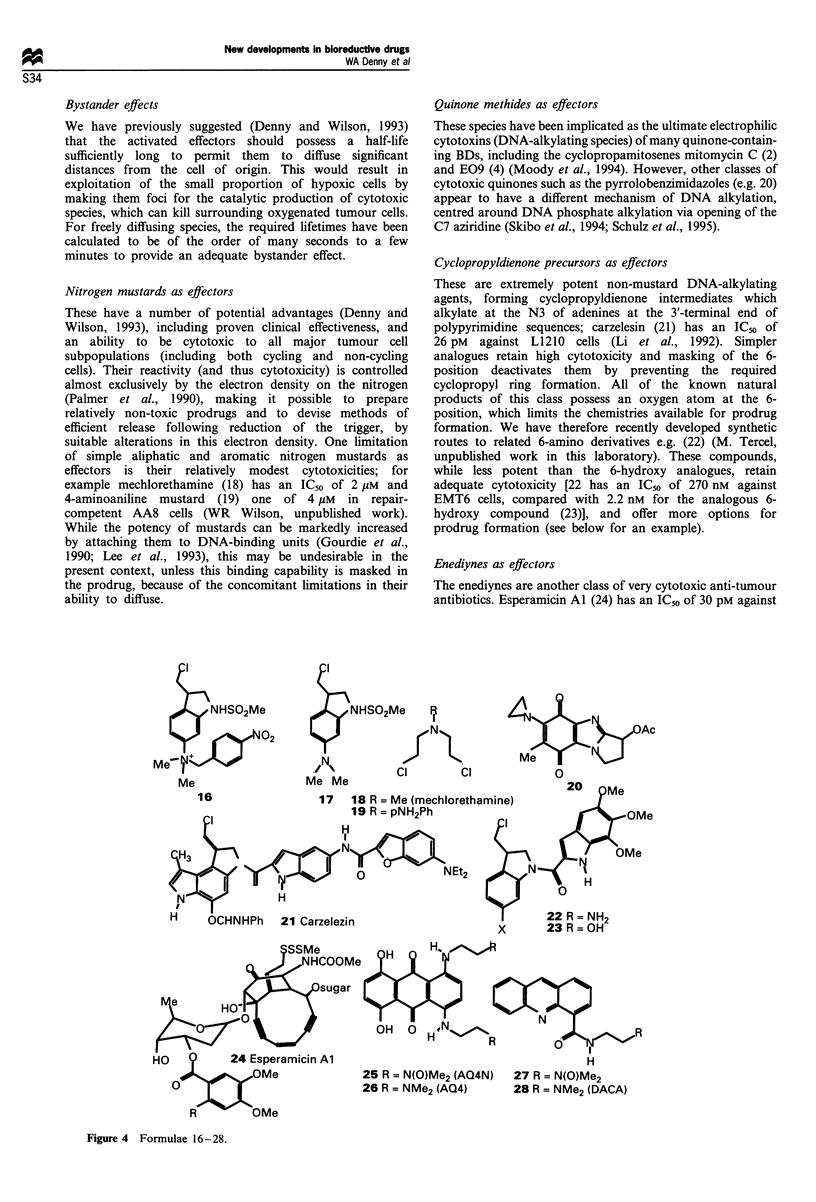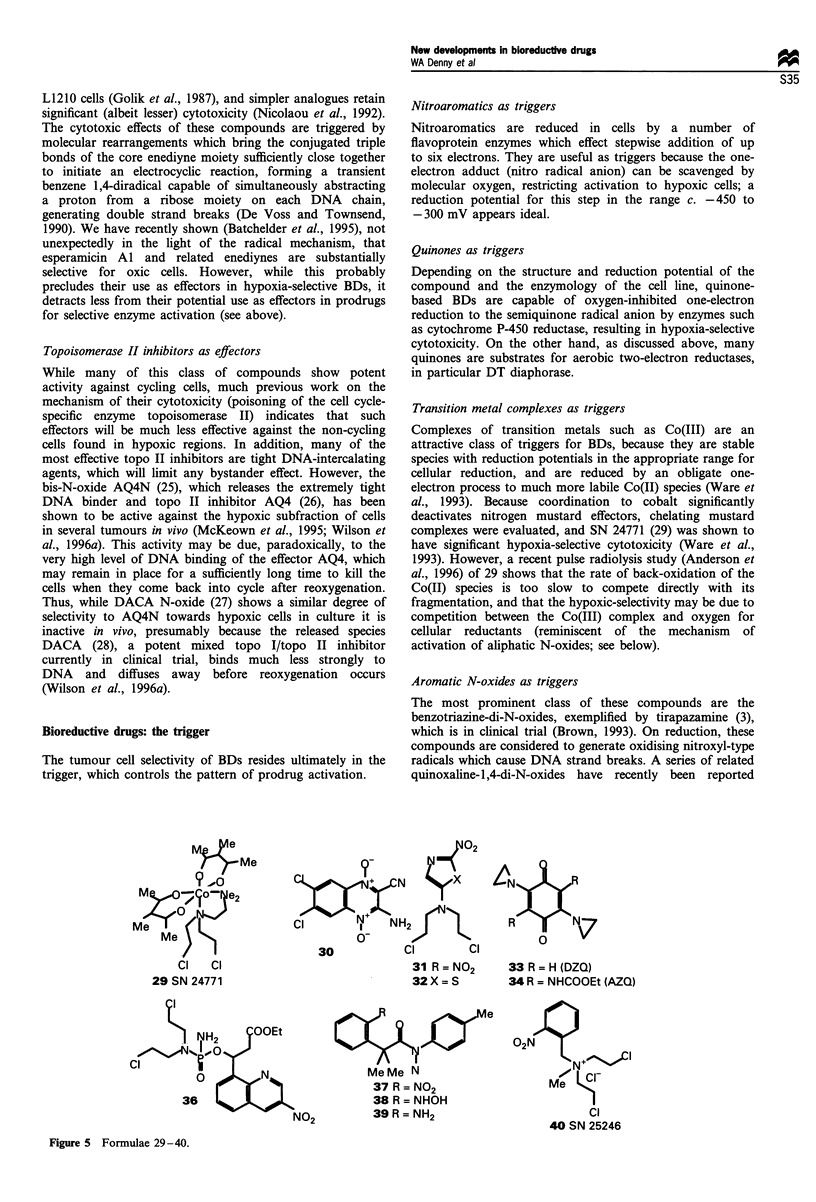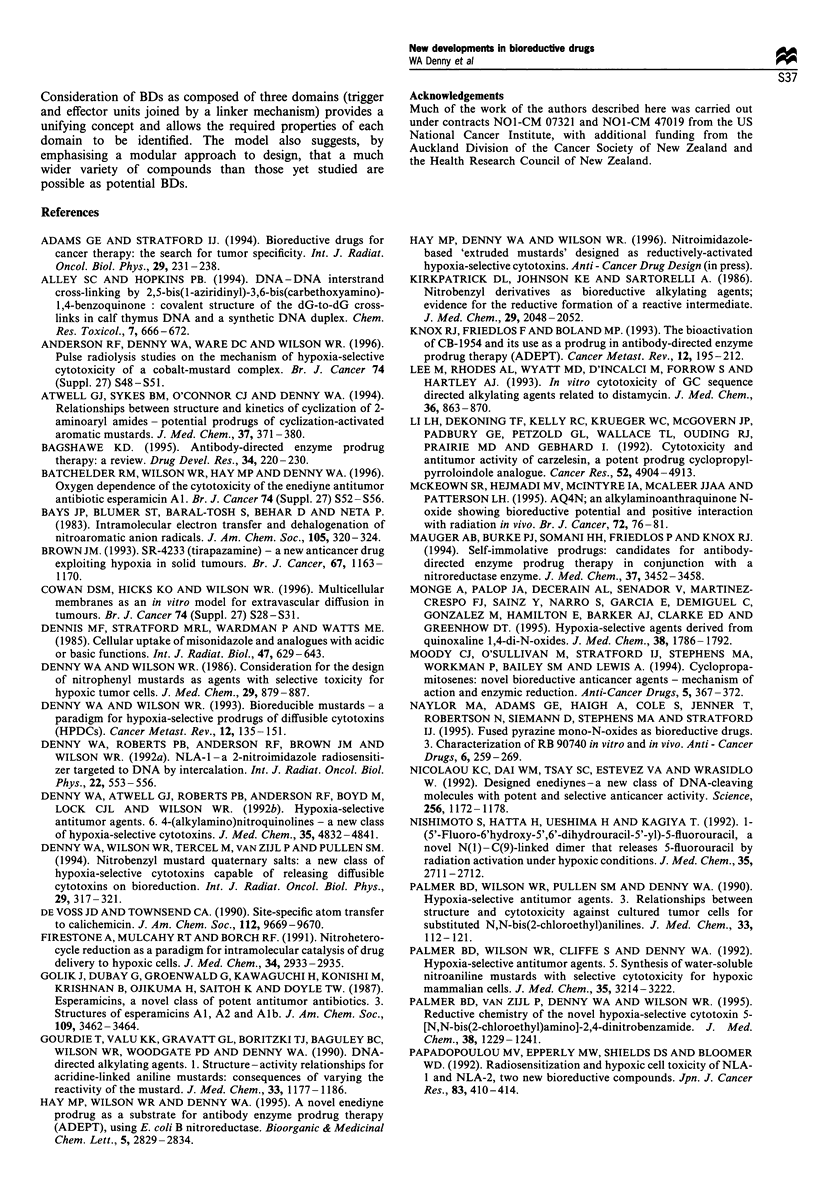Full text
PDF






Selected References
These references are in PubMed. This may not be the complete list of references from this article.
- Adams G. E., Stratford I. J. Bioreductive drugs for cancer therapy: the search for tumor specificity. Int J Radiat Oncol Biol Phys. 1994 May 15;29(2):231–238. doi: 10.1016/0360-3016(94)90267-4. [DOI] [PubMed] [Google Scholar]
- Alley S. C., Hopkins P. B. DNA-DNA interstrand cross-linking by 2,5-bis(1-aziridinyl)-3,6-bis(carbethoxyamino)-1,4-benzoquinone: covalent structure of the dG-to-dG cross-links in calf thymus DNA and a synthetic DNA duplex. Chem Res Toxicol. 1994 Sep-Oct;7(5):666–672. doi: 10.1021/tx00041a012. [DOI] [PubMed] [Google Scholar]
- Anderson R. F., Denny W. A., Ware D. C., Wilson W. R. Pulse radiolysis studies on the hypoxia-selective toxicity of a colbalt-mustard complex. Br J Cancer Suppl. 1996 Jul;27:S48–S51. [PMC free article] [PubMed] [Google Scholar]
- Atwell G. J., Sykes B. M., O'Connor C. J., Denny W. A. Relationships between structure and kinetics of cyclization of 2-aminoaryl amides: potential prodrugs of cyclization-activated aromatic mustards. J Med Chem. 1994 Feb 4;37(3):371–380. doi: 10.1021/jm00029a009. [DOI] [PubMed] [Google Scholar]
- Batchelder R. M., Wilson W. R., Hay M. P., Denny W. A. Oxygen dependence of the cytotoxicity of the enediyne anti-tumour antibiotic esperamicin A1. Br J Cancer Suppl. 1996 Jul;27:S52–S56. [PMC free article] [PubMed] [Google Scholar]
- Brown J. M. SR 4233 (tirapazamine): a new anticancer drug exploiting hypoxia in solid tumours. Br J Cancer. 1993 Jun;67(6):1163–1170. doi: 10.1038/bjc.1993.220. [DOI] [PMC free article] [PubMed] [Google Scholar]
- Dennis M. F., Stratford M. R., Wardman P., Watts M. E. Cellular uptake of misonidazole and analogues with acidic or basic functions. Int J Radiat Biol Relat Stud Phys Chem Med. 1985 Jun;47(6):629–643. doi: 10.1080/09553008514550871. [DOI] [PubMed] [Google Scholar]
- Denny W. A., Atwell G. J., Roberts P. B., Anderson R. F., Boyd M., Lock C. J., Wilson W. R. Hypoxia-selective antitumor agents. 6. 4-(Alkylamino)nitroquinolines: a new class of hypoxia-selective cytotoxins. J Med Chem. 1992 Dec 25;35(26):4832–4841. doi: 10.1021/jm00104a008. [DOI] [PubMed] [Google Scholar]
- Denny W. A., Roberts P. B., Anderson R. F., Brown J. M., Phil D., Wilson W. R. NLA-1: a 2-nitroimidazole radiosensitizer targeted to DNA by intercalation. Int J Radiat Oncol Biol Phys. 1992;22(3):553–556. doi: 10.1016/0360-3016(92)90874-h. [DOI] [PubMed] [Google Scholar]
- Denny W. A., Wilson W. R. Bioreducible mustards: a paradigm for hypoxia-selective prodrugs of diffusible cytotoxins (HPDCs). Cancer Metastasis Rev. 1993 Jun;12(2):135–151. doi: 10.1007/BF00689806. [DOI] [PubMed] [Google Scholar]
- Denny W. A., Wilson W. R. Considerations for the design of nitrophenyl mustards as agents with selective toxicity for hypoxic tumor cells. J Med Chem. 1986 Jun;29(6):879–887. doi: 10.1021/jm00156a001. [DOI] [PubMed] [Google Scholar]
- Denny W. A., Wilson W. R., Tercel M., Van Zijl P., Pullen S. M. Nitrobenzyl mustard quaternary salts: a new class of hypoxia-selective cytotoxins capable of releasing diffusible cytotoxins on bioreduction. Int J Radiat Oncol Biol Phys. 1994 May 15;29(2):317–321. doi: 10.1016/0360-3016(94)90282-8. [DOI] [PubMed] [Google Scholar]
- Firestone A., Mulcahy R. T., Borch R. F. Nitroheterocycle reduction as a paradigm for intramolecular catalysis of drug delivery to hypoxic cells. J Med Chem. 1991 Sep;34(9):2933–2935. doi: 10.1021/jm00113a040. [DOI] [PubMed] [Google Scholar]
- Gourdie T. A., Valu K. K., Gravatt G. L., Boritzki T. J., Baguley B. C., Wakelin L. P., Wilson W. R., Woodgate P. D., Denny W. A. DNA-directed alkylating agents. 1. Structure-activity relationships for acridine-linked aniline mustards: consequences of varying the reactivity of the mustard. J Med Chem. 1990 Apr;33(4):1177–1186. doi: 10.1021/jm00166a015. [DOI] [PubMed] [Google Scholar]
- Kirkpatrick D. L., Johnson K. E., Sartorelli A. C. Nitrobenzyl derivatives as bioreductive alkylating agents: evidence for the reductive formation of a reactive intermediate. J Med Chem. 1986 Oct;29(10):2048–2052. doi: 10.1021/jm00160a043. [DOI] [PubMed] [Google Scholar]
- Knox R. J., Friedlos F., Boland M. P. The bioactivation of CB 1954 and its use as a prodrug in antibody-directed enzyme prodrug therapy (ADEPT). Cancer Metastasis Rev. 1993 Jun;12(2):195–212. doi: 10.1007/BF00689810. [DOI] [PubMed] [Google Scholar]
- Lee M., Rhodes A. L., Wyatt M. D., D'Incalci M., Forrow S., Hartley J. A. In vitro cytotoxicity of GC sequence directed alkylating agents related to distamycin. J Med Chem. 1993 Apr 2;36(7):863–870. doi: 10.1021/jm00059a011. [DOI] [PubMed] [Google Scholar]
- Li L. H., DeKoning T. F., Kelly R. C., Krueger W. C., McGovren J. P., Padbury G. E., Petzold G. L., Wallace T. L., Ouding R. J., Prairie M. D. Cytotoxicity and antitumor activity of carzelesin, a prodrug cyclopropylpyrroloindole analogue. Cancer Res. 1992 Sep 15;52(18):4904–4913. [PubMed] [Google Scholar]
- Mauger A. B., Burke P. J., Somani H. H., Friedlos F., Knox R. J. Self-immolative prodrugs: candidates for antibody-directed enzyme prodrug therapy in conjunction with a nitroreductase enzyme. J Med Chem. 1994 Oct 14;37(21):3452–3458. doi: 10.1021/jm00047a002. [DOI] [PubMed] [Google Scholar]
- McKeown S. R., Hejmadi M. V., McIntyre I. A., McAleer J. J., Patterson L. H. AQ4N: an alkylaminoanthraquinone N-oxide showing bioreductive potential and positive interaction with radiation in vivo. Br J Cancer. 1995 Jul;72(1):76–81. doi: 10.1038/bjc.1995.280. [DOI] [PMC free article] [PubMed] [Google Scholar]
- Monge A., Palop J. A., López de Ceráin A., Senador V., Martínez-Crespo F. J., Sainz Y., Narro S., García E., de Miguel C., González M. Hypoxia-selective agents derived from quinoxaline 1,4-di-N-oxides. J Med Chem. 1995 May 12;38(10):1786–1792. doi: 10.1021/jm00010a023. [DOI] [PubMed] [Google Scholar]
- Moody C. J., O'Sullivan N., Stratford I. J., Stephens M. A., Workman P., Bailey S. M., Lewis A. Cyclopropamitosenes: novel bioreductive anticancer agents--mechanism of action and enzymic reduction. Anticancer Drugs. 1994 Jun;5(3):367–372. [PubMed] [Google Scholar]
- Naylor M. A., Adams G. E., Haigh A., Cole S., Jenner T., Robertson N., Siemann D., Stephens M. A., Stratford I. J. Fused pyrazine mono-N-oxides as bioreductive drugs. III. Characterization of RB 90740 in vitro and in vivo. Anticancer Drugs. 1995 Apr;6(2):259–269. doi: 10.1097/00001813-199504000-00010. [DOI] [PubMed] [Google Scholar]
- Nicolaou K. C., Dai W. M., Tsay S. C., Estevez V. A., Wrasidlo W. Designed enediynes: a new class of DNA-cleaving molecules with potent and selective anticancer activity. Science. 1992 May 22;256(5060):1172–1178. doi: 10.1126/science.256.5060.1172. [DOI] [PubMed] [Google Scholar]
- Nishimoto S., Hatta H., Ueshima H., Kagiya T. 1-(5'-Fluoro-6'-hydroxy-5',6'-dihydrouracil-5'-yl)-5-fluorouracil, a novel N(1)-C(5)-linked dimer that releases 5-fluorouracil by radiation activation under hypoxic conditions. J Med Chem. 1992 Jul 10;35(14):2711–2712. doi: 10.1021/jm00092a023. [DOI] [PubMed] [Google Scholar]
- Palmer B. D., Wilson W. R., Cliffe S., Denny W. A. Hypoxia-selective antitumor agents. 5. Synthesis of water-soluble nitroaniline mustards with selective cytotoxicity for hypoxic mammalian cells. J Med Chem. 1992 Aug 21;35(17):3214–3222. doi: 10.1021/jm00095a018. [DOI] [PubMed] [Google Scholar]
- Palmer B. D., Wilson W. R., Pullen S. M., Denny W. A. Hypoxia-selective antitumor agents. 3. Relationships between structure and cytotoxicity against cultured tumor cells for substituted N,N-bis(2-chloroethyl)anilines. J Med Chem. 1990 Jan;33(1):112–121. doi: 10.1021/jm00163a019. [DOI] [PubMed] [Google Scholar]
- Palmer B. D., van Zijl P., Denny W. A., Wilson W. R. Reductive chemistry of the novel hypoxia-selective cytotoxin 5-[N,N-bis(2-chloroethyl)amino]-2,4-dinitrobenzamide. J Med Chem. 1995 Mar 31;38(7):1229–1241. doi: 10.1021/jm00007a019. [DOI] [PubMed] [Google Scholar]
- Papadopoulou M. V., Epperly M. W., Shields D. S., Bloomer W. D. Radiosensitization and hypoxic cell toxicity of NLA-1 and NLA-2, two new bioreductive compounds. Jpn J Cancer Res. 1992 Apr;83(4):410–414. doi: 10.1111/j.1349-7006.1992.tb00123.x. [DOI] [PMC free article] [PubMed] [Google Scholar]
- Patterson L. H., Craven M. R., Fisher G. R., Teesdale-Spittle P. Aliphatic amine N-oxides of DNA binding agents as bioreductive drugs. Oncol Res. 1994;6(10-11):533–538. [PubMed] [Google Scholar]
- Ross D., Siegel D., Beall H., Prakash A. S., Mulcahy R. T., Gibson N. W. DT-diaphorase in activation and detoxification of quinones. Bioreductive activation of mitomycin C. Cancer Metastasis Rev. 1993 Jun;12(2):83–101. doi: 10.1007/BF00689803. [DOI] [PubMed] [Google Scholar]
- Sartorelli A. C. Therapeutic attack of hypoxic cells of solid tumors: presidential address. Cancer Res. 1988 Feb 15;48(4):775–778. [PubMed] [Google Scholar]
- Schulz W. G., Islam I., Skibo E. B. Pyrrolo[1,2-a]benzimidazole-based quinones and iminoquinones. The role of the 3-substituent on cytotoxicity. J Med Chem. 1995 Jan 6;38(1):109–118. doi: 10.1021/jm00001a016. [DOI] [PubMed] [Google Scholar]
- Siim B. G., Denny W. A., Wilson W. R. Does DNA targeting affect the cytotoxicity and cell uptake of basic nitroquinoline bioreductive drugs? Int J Radiat Oncol Biol Phys. 1994 May 15;29(2):311–315. doi: 10.1016/0360-3016(94)90281-x. [DOI] [PubMed] [Google Scholar]
- Skibo E. B., Islam I., Heileman M. J., Schulz W. G. Structure-activity studies of benzimidazole-based DNA-cleaving agents. Comparison of benzimidazole, pyrrolobenzimidazole, and tetrahydropyridobenzimidazole analogues. J Med Chem. 1994 Jan 7;37(1):78–92. doi: 10.1021/jm00027a010. [DOI] [PubMed] [Google Scholar]
- Smitskamp-Wilms E., Peters G. J., Pinedo H. M., van Ark-Otte J., Giaccone G. Chemosensitivity to the indoloquinone EO9 is correlated with DT-diaphorase activity and its gene expression. Biochem Pharmacol. 1994 Apr 20;47(8):1325–1332. doi: 10.1016/0006-2952(94)90330-1. [DOI] [PubMed] [Google Scholar]
- Verweij J., Aamdal S., Schellens J., Koier I., Lund B. Clinical studies with EO9, a new indoloquinone bioreductive alkylating cytotoxic agent. EORTC Early Clinical Trials Group. Oncol Res. 1994;6(10-11):519–523. [PubMed] [Google Scholar]
- Ware D. C., Palmer B. D., Wilson W. R., Denny W. A. Hypoxia-selective antitumor agents. 7. Metal complexes of aliphatic mustards as a new class of hypoxia-selective cytotoxins. Synthesis and evaluation of cobalt(III) complexes of bidentate mustards. J Med Chem. 1993 Jun 25;36(13):1839–1846. doi: 10.1021/jm00065a006. [DOI] [PubMed] [Google Scholar]
- Wilson W. R., Denny W. A., Pullen S. M., Thompson K. M., Li A. E., Patterson L. H., Lee H. H. Tertiary amine N-oxides as bioreductive drugs: DACA N-oxide, nitracrine N-oxide and AQ4N. Br J Cancer Suppl. 1996 Jul;27:S43–S47. [PMC free article] [PubMed] [Google Scholar]
- Workman P., Stratford I. J. The experimental development of bioreductive drugs and their role in cancer therapy. Cancer Metastasis Rev. 1993 Jun;12(2):73–82. doi: 10.1007/BF00689802. [DOI] [PubMed] [Google Scholar]


